Trucker Access › Forums › Diesel News › How to Get More Out of Commercial Driver Vehicle Inspections – Safety & Compliance
- This topic has 0 replies, 1 voice, and was last updated 9 months, 2 weeks ago by
 EazyRiDer66.
EazyRiDer66.
-
AuthorPosts
-
May 15, 2024 at 11:00 am #20582
 EazyRiDer66Keymaster
EazyRiDer66Keymaster
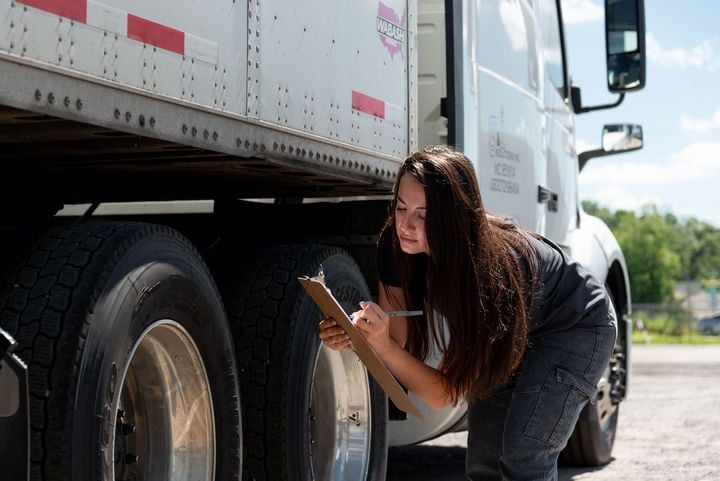
Driver vehicle inspections, pre-trip and post-trip, are an important part of keeping vehicles running safely.
Photo: Gordon Hansen for HDT
When Tom Bray was in charge of safety at a motor carrier, a frustration was seeing drivers leave the yard with an easily correctable problem that could result in a violation or worse — but should have been found in a driver vehicle inspection and fixed.
“I’d watch a truck roll out the driveway, and I’d see his left turn signal on the side of the tractor and on the side of the trailer,” he says. “But it wasn’t working on the back of the trailer. You’re pulling out of our facility with 30 mechanics dying to work on your vehicle, and you’re leaving with a turn signal that doesn’t work? Come on!”
Bray is a business advisor with J.J. Keller, working with fleets on safety and compliance. His experience ranges from being a truck driver to a trainer to a safety director, so he knows a thing or two about pre-trip and post-trip driver inspections.
So does Fred Fakkema, who was a commercial motor vehicle inspector for years and is now vice president of safety and compliance for Zonar, which got its start developing some of the first electronically verified inspections.
Fakkema points out that the top violation during roadside inspections is “inoperable required lamp” — an easy thing to find during a proper pre-trip inspection. Turn signals, tires, windshield wipers, are all common things that driver inspections should catch.
And when an enforcement officer spots low-hanging fruit like that, they’re going to start digging for more violations, Fakkema says.
“Because you got that missing light, now you’re getting dinged for your hours of service,” he says.
Similarly, one of the biggest issues that happen when trucks leave the yard are tire-related, says Michael Dominguez, VP of business operations, procurement and fleet management for Transervice Logistics, a provider of dedicated contract carriage.
Tire problems could lead to violations during roadside inspections or to a blow-out on the road. The latter, especially in a steer tire, could have serious repercussions.
And all this could have been prevented by making sure the tire pressure was right before departure.
“Doing the proper pre-trip not only gets you in compliance, but it increases the safety of your fleet as well,” Fakkema says. “You’d think that with the cost of maintenance today, the cost of fuel today, that you’d want to reduce those costs by actually doing a proper pre- and post-trip.”
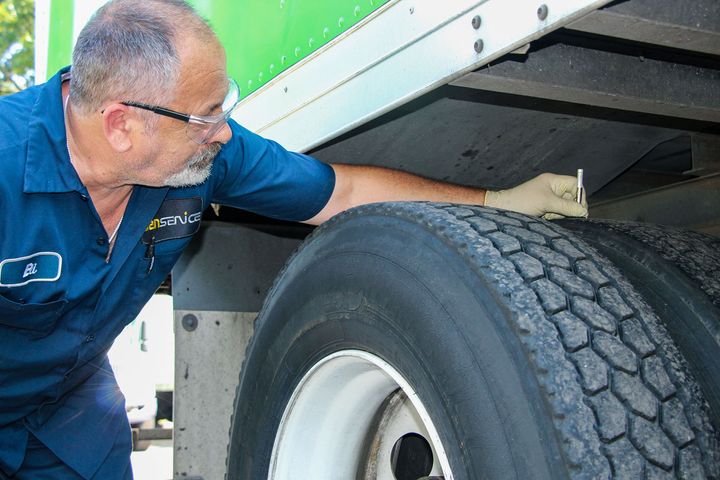
Tire-related problems are a common reason for roadside inspection violations that often could have been found during a pre-trip inspection.
Stop Drivers from ‘Pencil-Whipping’ Inspections
Every driver is trained when they’re getting their commercial driver’s license to do pre-trip and post-trip inspections. It’s part of the test they must pass to get a license.
“But most sit in the cab and check the box,” Fakkema says. “It used to be called pencil-whipping because they used paper forms. Now there’s a lot of electronics, but it’s still just checking the box and not getting butts out of the seat and actually walk around the truck.”
Drivers want to drive. That’s what they get paid for, that’s why they got into this business. They don’t want to spend a lot of time doing inspections or filling out paperwork.
Barrett Young, chief marketing officer for Netradyne, says the conversation around vehicle inspections and driver vehicle inspection reports is similar to the adoption of dashcams — drivers just don’t want to do it.
“I don’t want to do it. So don’t make me do it. And I don’t see the importance of it,” he says of the mindset of many drivers. “Only do they really start to experience the gravitas or the importance of it is when something goes wrong.”
If Your Fleet Doesn’t Priorize Driver Inspections, Drivers Won’t Either
If the company and its leadership don’t put a priority on pre- and post-trip inspections, drivers won’t, either.
“Whether I go out to a location or somebody above or below me goes out to a location, we’re looking to see if the hoods are popped and the fluids are being checked and the lights are going around and you hear the air brake checks going on,” says Transervice’s Dominguez. “If you don’t set that expectation that this has to get done,” it won’t.
Companies that have good maintenance scores in the Federal Motor Carrier Safety Administration’s CSA safety scoring program, he says, “put a big emphasis on, ‘We’re not leaving the yard unless we’ve done the proper pre-trip inspection.”‘
At Transervice, often someone from the shop is out in the yard ready to help drivers with pre-trip inspections and fast repairs, Dominguez says.
“The driver is trying to get out on the road,” he says. “If there’s a guy out there in the parking lot with a cart and oil and bulbs and asking, ‘Hey, do you need something,’ it goes a long way toward making sure that the driver can do his pre-trip and get out of the yard in the most efficient amount of time. So having that collaboration goes a long way.”
Keller’s Bray says, “If you give the concept of driver vehicle inspections lip service, that’s going to be their attitude toward them. If they think you don’t take it seriously, they’re not going to take it seriously.”
He says setting those expectations starts with driver training.
“If you lay down that expectation initially, that goes a long way towards getting the drivers to start doing it,” Bray says.
Zonar’s Fakkema also speaks to the importance of company culture, saying pre-trip inspections can help drivers have a safety mindset before they leave the yard.
“You know, in sports, we stretch and we get ready to do what we do, and get in that mindset to play that day’s game,” he says. “If you’re doing a good pre-trip and you’re thinking about how you’re going to get back home safely, that pre-trip really gets you in that mindset.”
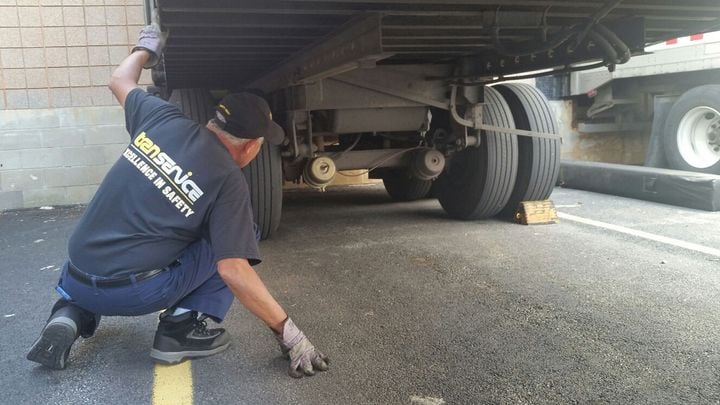
Bending over or crouching down to take a look under the vehicle during a driver inspection can catch problems not otherwise visible.
Give Drivers the Big Picture on Why Inspections Matter
Steve Keppler, co-director of Scopelitis Transportation Consulting, worked as an investigator and inspector for the Office of Motor Carriers (the FMCSA’s predecessor) and spent 15 years at the Commercial Vehicle Safety Alliance. Today he works with fleets on safety and compliance issues.
Fleets he’s worked with that have been successful in getting drivers to do proper inspections spend some time showing drivers real-world scenarios about what can happen when there’s a breakdown or out-of-service violation that could have been prevented with a driver inspection. That may include the cost of on-the-road maintenance, what violations do to fleet CSA scores, what the cost was of not being able to deliver a load on time, the possibility that the fleet could lose the customer.
“And by the way, you didn’t get home in time,” Keppler says. “You’re waiting out on the road to get a truck fixed and you didn’t get home in time and you missed your son’s or daughter’s game.
“Put it in real-world terms, so that it’s not just a driver issue. It’s a fleet issue.”
Dominguez has found it effective to bring in a commercial motor vehicle enforcement official to walk drivers through a true inspection training, including teaching them about how violations affect the drivers’ own CSA scores.
“Somebody internally could be having that conversation [with drivers] twice a year, and then somebody from DOT comes in and has that conversation, and it’s like, ‘Wow, that’s new news to me.’”
Invest in Driver Training for Better Pre-trip Inspections
Commercial drivers must know how to do a vehicle inspection in order to pass the test for their commercial drivers’ license. But don’t assume that means they’re doing it well or efficiently.
“That’s one of the issues that comes into play, especially with new drivers,” says Keller’s Bray. “For them to do a full-blown tractor-trailer inspection after coming out of most typical training programs, that’s a half an hour to 45 minutes. They’re just not very efficient at doing it.
“Then the push is, ‘This is costing me too much, so I’ll start cutting out parts of the inspection.’ Next thing you know, they’re not doing the inspection.”
The snow in Wisconsin gives Bray an interesting technique to illustrate how pre-trips aren’t done efficiently.
With fresh snow on the ground, he’ll ask a trainee to do a pre-trip inspection. “I kind of stand back and I watch how many times they went around the vehicle,” he says.
While drivers do need to make a couple of trips to check certain things such as brake lights, he says, “I see new drivers and even experienced drivers take eight or 10 laps around the truck. That’s when you step in as a trainer and say, ‘Look at all your footprints around the truck. That’s a lot of wasted motion, a lot of wasted time. Let’s get a pattern set up so that you’re not walking past things that you need to be checking.”
“The training you gave them hopefully gives them enough knowledge and skill that they can quickly and efficiently do the inspection and find the issues that you want them finding if they’re present on the vehicle,” Bray says. “If they’re not getting it done quickly, they’re just going to give it up.”
Bray also points out that while the FMCSA doesn’t expect drivers to get on a creeper and go underneath the vehicle, a driver can pick up on problems that aren’t as obvious by bending or crouching down and looking under the vehicle.
“There’s times where the driver, if they would have looked under, they’d have seen that brake chamber that broke loose from its mount or that airline hanging down lower than it should.”
Help Truck Drivers Make Vehicle Inspections More Efficient
Dominguez says whether you’re using old-school paper inspection checklists or an electronic inspection checklist on a phone or tablet, those forms should be laid out in the most efficient process for drivers to get it done.
“That’s a practice that we use even in our PMs and also use it in our DVIR,” he says, “is to try to have it in a flow that makes the most sense, so they can easily go around that truck and check everything as they hit the four corners.”
Bray and Dominguez both point out that whenever a driver gets a different truck, it may have different features that need to be checked, or that are in different places than he or she is used to.
“Even if you’ve hired an experienced driver from another company, your equipment’s unique,” Bray says. And not every vehicle within a fleet is identical, either. There are subtle changes from one model year to another, even in the same model, he adds, and fleets with mixed makes are going to have even more differences.
The Role of Maintenance in Truck Driver Vehicle Inspections
If there’s not a good relationship between drivers and the shop, if drivers don’t feel their inspection reports are being addressed, they have less incentive to do proper inspections.
“It’s never a good situation if a company has pillars between the maintenance shop and the drivers,” says Dominguez. “If there’s animosity in trying to work together, even more reason that the driver is not going to put a lot of emphasis on it.”
Dominguez says it’s vital that driver inspections be an extension of the overall preventive maintenance program.
“One of the things that works really well is that when we do have a violation and even breakdowns, we do an analysis. Could it have been prevented, one, from the last PM, and two, from the DVIR.
“And I say it in that fashion, because the DVIR needs to be an extension of the PM process.”
A truck may have a preventive maintenance inspection every three months or every six months, but in between, “You rely on the driver on a daily basis telling you, ‘I’ve got a light out, I’ve got a mudflap that’s going, I hear this noise, I see something that seems a little bit off.’ You’re looking for all those minor things that can happen in between PMs to be identified by that pre-trip DVIR or post-trip DVIR.”
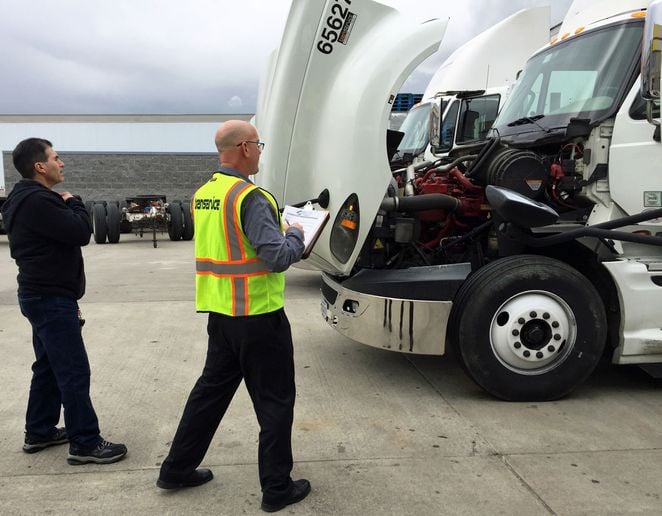
Transervice often has maintenance personnel in the yard to help drivers with pre-trip inspections.
Keppler also advises fleets not to overlook how technicians are doing their PM inspections.
“Maintenance folks like to fix stuff,” he says, and may focus on fixing problems without doing a real inspection. That’s why it’s critical to have a uniform procedure for technician inspections, he says.
“That inspection should be done the same way every time, regardless of what the driver tells you. If you find stuff, don’t stop and fix it. Note it, do the inspection the way you’re supposed to do, document everything, and then you can worry about how you’re going to get it fixed.”
Getting the Problem Fixed After the Inspection
Once a driver has reported a safety-related defect, it’s sometimes not fixed promptly. And that’s a problem, says Keller’s Bray.
“You can’t have the driver filling out paper DVIRs or even doing electronic ones and telling you six days in a row that he has a bad tire, and you’re not doing anything about it. That causes all kinds of problems during an audit.
“Some companies still believe that the driver just fills them out and when he gets back to the terminal in a week, he turns them all in. No, that’s not at all how that works,” Bray adds.
“In a post-crash environment, if that tire failure leads to loss of control, there’s going to be a lot of people saying, what are you doing?”
One of the reasons drivers say they don’t pay more attention to their vehicle inspections and DVIRs is that they keep reporting the same problem that doesn’t get fixed.
Regulations don’t require a defect found during a driver inspection to be fixed right away if it’s not critical to the safe operation of the vehicle. If the driver reports a problem that isn’t going to be fixed right away, Keppler says, “they need to tell the driver that, ‘We’re going to get it fixed, just not right now.’
“I look at lots of DVRs where I see the same thing appearing over and over,” he says. “A lot of times, if it’s the same driver, as days go on, their writing will get larger, they’ll put exclamation points on the DVIR, because they’re upset that people aren’t paying attention to it.
“That’s on management, to have that feedback loop to the driver,” he says.
Similarly, Keppler says, it’s important to make sure technicians and drivers complete the loop following a repair.
“The driver that gets in the vehicle the next time needs to review that the issues were fixed, and they need to see a mechanic certification that they were fixed. A lot of times you don’t see that mechanic certification on there. The driver should be asking questions about that — and they shouldn’t be penalized for that, they should be encouraged to do that.”
Bray recalls a driver with a fleet he was working at “who was extremely agitated, because his seat squeaked.”
He told the driver that it would be fixed when the truck came in for service, “but we’re not sending you into a dealership to have your squeak on your seat fixed,” because it’s not a safety violation.
Driver Inspections Should be Part of a Holistic Maintenance Approach
Keppler says driver pre-trips and post-trips and DVIRs should be part of a more holistic approach.
“I look at vehicle inspections as a three-legged stool,” he says:
- Pre- and post-trip inspections by the driver.
- Periodic inspections, primarily done by the maintenance department, including the mandatory annual inspection
- Roadside inspections done by commercial motor vehicle enforcement officials.
“If you’ve got a good systematic maintenance program in place, all legs of the stool are strong,” he says. “But if you’ve got one of those areas that’s failing, the stool falls over. And so they all need to be working in harmony.
“When we go in and audit a carrier, what we’re going to look at is how those three legs of the stool work together,” Keppler says. “So we’re going to look at a roadside inspection. What violations were discovered during that roadside inspection? What day did it happen? We’re going to map that back and take a look at the pre-trips. Was a pre-trip done on that vehicle for that day? Did the driver discover anything that the driver notated as defects?
“We’re also going to look at the most recent periodic inspection. What did that inspection uncover, If anything? Was it close to the time that the roadside inspection took place? Was the out-of-service condition something that’s latent, that’s probably been there a while that could have been picked up during a periodic inspection?”
But many fleets, he says, don’t do that kind of analysis.
“When you go in and look their maintenance files, the DVIRs are in one place, the periodic inspections are in one place, and the roadside inspections are in another place. They’re not collated together.
“Most fleets are not taking that approach to their maintenance program from a compliance and safety perspective. They’re taking a Band-Aid approach: ‘Fix it when it happens, and we’ll deal with it the next time something happens.’ And that’s a problem.”
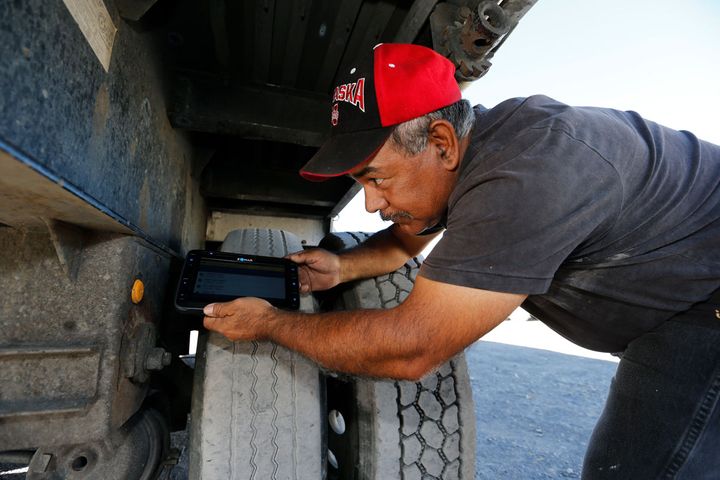
There are various e-DVIRs to help make driver vehicle inspections and filing defect reports easier. This one from Zonar uses RFID tags to prompt the driver to inspection varous zones around the truck.
How e-DVIRs Can Help Make Driver Vehicle Inspections Better
Using traditional paper-based driver vehicle inspection systems is time-consuming and subject to inaccuracies (“What did the driver write here?”) and delays. Electronic driver vehicle inspection checklists and driver vehicle inspection reports are available from a number of providers, often accessed through the driver’s electronic logging device or a mobile device.
What is an e-DVIR? As Whip Around explains, e-DVIRs allow drivers to quickly fill out an inspection form from their mobile device, take images and make notes on vehicle faults, and automatically send in the report.
“It’s easy to miss something on a paper report and chalk it up to simple forgetfulness,” the company explains on its website. “With Whip Around you can’t miss something in your pre-trip vehicle inspection because you have to physically check off an item before you can move onto the next one.”
“One of the big benefits of the e-DVIR is that it’s added some level of automation in the sense that it makes it easier,” says Netradyne’s Young. “You go through a very defined checklist that you would on paper. And it’s kind of checking your boxes inside the app or on your phone or whatever device is being used.
“But the really important part is the automation of the maintenance request,” he says. When a driver has discovered a problem, a report automatically goes into the back-end portal for fleet managers. Drivers can even attach a photo of the problem, sometimes video. Some integrate into a fleet’s maintenance management software.
“Before you know it, you’re back in the terminal the next day, and they can get that fixed immediately, where previously that would take weeks sometimes.”
Not only does that mean less frustration and downtime for the driver, but it also has a major benefit for fleets in terms of liability, Young says. When it takes a week or more for a traditional DVIR to get processed and maintenance/repair performed, “That means that vehicle’s on the road for X amount of days or potentially a week or two, before maintenance is actually scheduled or taken care of. And that is a liability issue at its finest.”
Why e-DVIRs Are Especially Useful for Long-Haul Trucking Fleets
J.J. Keller’s Bray says the e-DVIR is especially helpful when you have trucks and drivers that operate far from their home terminal.
Say you’re a fleet in Wisconsin and you have a driver out in Sacramento.
With an e-DVIR, he says, “The driver writes up he’s got a light out, and that immediately shows up in the maintenance person’s inbox. So he says, ‘I got a truck in Sacramento with a light out, let’s get this squared away.’ He gets it squared away, then loads the e-DVIR back up into the system after he signed off on it saying it’s been taken care of. Then the next driver just retrieves it and signs off on it and everything’s taken care of.”
Keppler also points to the benefits of e-DVIRs in making it easier for fleets to connect everything together.
“You can monitor those periodic inspections, you can monitor the roadside inspections, you can monitor their pre-and post-trips, you can monitor the repair work,” he says.
“A lot of fleets even take it to the next level. Once you have the information in an electronic database, you can do all kinds of analysis on it. You can do predictive analytics; you can start getting to the next level of not just being reactive.”
How to Incentivize Your Drivers to Do Vehicle Inspections
When it comes to incentivizing drivers to do inspections, “I think you have to be somewhat creative in this space, because it’s a requirement that they do it every day,” Keppler says, “versus like a roadside inspection, if you get a clean inspection, a lot of fleets offer a monetary benefit there.”
If you’re using an electronic DVIR system, he says, it’s relatively easy to look at drivers’ DVIRs and set up a bonus or recognition system for doing all their DVIRs on time.
“And you can look at gamification, too,” he says, with drivers or terminals competing against each other.
In addition, he suggests that drivers who excel at their inspections be offered the opportunity to serve as trainers to other drivers. “Part of advancement within the company and getting recognized for something that they do very well.”
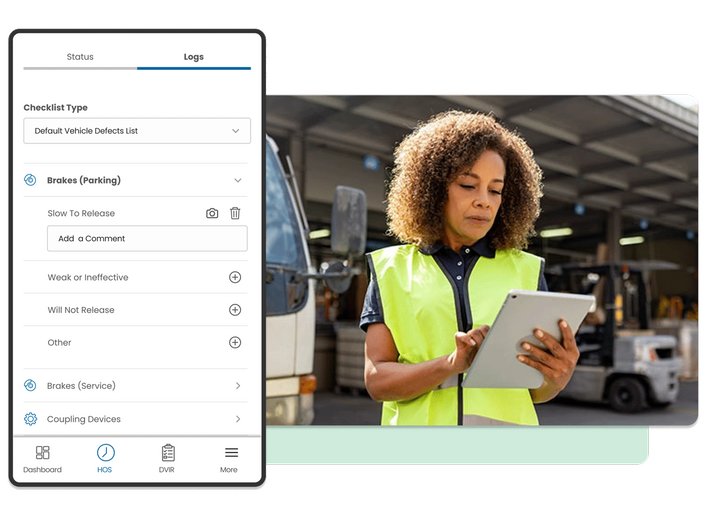
Electronic driver vehicle inspection reports make it more efficient to report defects and ensure safety-related problems are fixed promptly.
For vehicle inspections, as with other compliance elements, the carrot works better than the stick, says Netradyne’s Young.
“If you’re rewarding those who are doing it the way they should be, then those that are not doing it can see that reward and think, ‘Man, I wish I got qualified to enter to win that vacation my fleet’s offering because I checked all the boxes of things I was supposed to do this month.’
“Then you begin to improve compliance, simply by reinforcing and congratulating those that did it well. Punishing those that constantly don’t do well is just continuing to damage or increase a contentious relationship between the back office and drivers.”
-
AuthorPosts
- You must be logged in to reply to this topic.